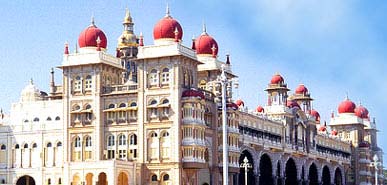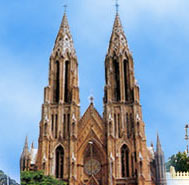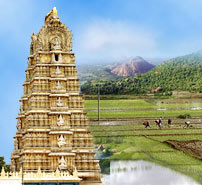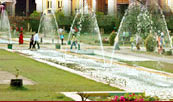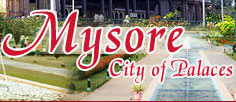The word Mysore is a corrupted version of "mysooru",
which is derived from the word "mahishur" or "Mahishasurana
Ooru", which means the town of Mahishasura in Kannada, the local
language. Mysore has been associated with the Puranic story found in the
Devi Bhagavatha. According to the story in the Devi Purana, Mysroe was
ruled by the demon Kind Mahishasura. Mahishasura was a buffalo-headed
monster. In response to the prayer by the Gods and Goddesses to save
them from the demon, Goddess Parvathi, took birth as Chamundeshwari and
killed the monster on top of the Chamundi hill near Mysore. Hence the
hill and the city have the names Chamundi Hill and Mysore respectively.
It is said that after killing the monster the Goddess stayed on top of
the hill, where she is worshipped with great devotion to this day. The
famous 10 daylong Dasara of Mysore is in honour of the Goddess
Chamundeshwari and is a celebration of this victory of good over evil.
Before the rise of the Gangas in the 10th century there is little
historical evidence relating to Mysore. The Gangas established their
supremacy in the 2nd century and they ruled over a large part of Mysore
till about 1004 AD. In the 3rd century they established their capital at
Talakad on the banks of the river Cauvery.
There is an inscription on Chamundi Hills that was done in 950AD during
the reign of the Gangas. This inscription is the oldest inscription
found in Mysore. The Cholas ruled Mysore for over a century after the
Gangas. The Chalukyas followed the Cholas. The Hoysalas drove the Cholas
from the remaining part of Mysore region in the 12th century. Hoysala
are known for the beautiful temples they built during their reign. It is
said that they built or expanded the existing temples in Mysore and on
the Chamundi Hills. There is an inscription in Mysore by the Hoysalas
that dates back to the 11th and 12th century.
After the Hoysalas came the Vijayanagar Kings and then the Mysore Yadu
dynasty came to power in 1399A.D. They were the feudatories of the
Vijayanagar Kings. This dynasty also contributed to temple building in
Mysore. Bettada Chamaraja Wodeyar, the raja of Mysore rebuilt the fort
of Mysore and made his headquarters and called the city 'Mahishura
Nagara' meaning the city of Mahishur. Many inscriptions done in the 17th
century and later refer to Mysore as 'Mahishuru'. Raja Wodeyar moved the
capital from Mysore to Srirangapatna. After the death of Tippu Sultan in
1799, Mysore became the capital of the Wodeyars once again.
During the reign of Krishnaraja Wodeyar III the town of Mysore expanded
and moved beyond the walls of the fort. Krishnaraja Wodeyar IV developed
Mysore into a beautiful city with excellent planning. Under his reign
Mysore became famous for its wide roads, magnificent building and
elegant parks. Today Mysore is a modern city that has managed to retain
its quaint old world charm. Today Mysore in famous in the world for its
sandalwood and rosewood artifacts, stone sculptures, incense sticks,
inlay work with ivory and its exquisite silk sarees.
